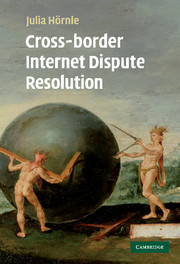Book contents
- Frontmatter
- Contents
- List of illustrations
- List of tables
- Table of cases
- Table of UK statutes
- Table of UK statutory instruments
- Table of European Communities legislation and documents
- Table of foreign statutes
- Table of treaties and conventions
- Acknowledgements
- List of abbreviations
- 1 Introduction
- 2 The concepts of fairness
- 3 Internet disputes
- 4 ADR and applicable law
- 5 ODR and access
- 6 Arbitration and due process
- 7 Internet disputes and fair arbitration
- 8 A model of dispute resolution for the Internet
- Bibliography
- Index
- References
3 - Internet disputes
Published online by Cambridge University Press: 30 November 2009
- Frontmatter
- Contents
- List of illustrations
- List of tables
- Table of cases
- Table of UK statutes
- Table of UK statutory instruments
- Table of European Communities legislation and documents
- Table of foreign statutes
- Table of treaties and conventions
- Acknowledgements
- List of abbreviations
- 1 Introduction
- 2 The concepts of fairness
- 3 Internet disputes
- 4 ADR and applicable law
- 5 ODR and access
- 6 Arbitration and due process
- 7 Internet disputes and fair arbitration
- 8 A model of dispute resolution for the Internet
- Bibliography
- Index
- References
Summary
If there is a technological advance without a social advance, there is, almost automatically, an increase in human misery.
(Michael Harrington, 1928–89)Introduction
The purpose of this chapter is to circumscribe the types of disputes this book is concerned with. It starts by conceptualising the characteristics underlying the Internet and why this makes the resolution of Internet disputes difficult. The chapter then discusses the nature of the Internet as a powerful multi-media communications channel, which has enabled individuals and consumers to take part in international interactions, cross-border E-commerce, international publishing and the distribution of user-generated content on an unprecedented scale. By way of illustration, this chapter sketches some typical international disputes that arise (or hypothetically may arise) on the Internet. This leads to a concern about cross-border disputes involving individuals, their access to cross-border litigation, and power imbalances, where one party has many more resources for disputing than the other.
Characteristics of the Internet
By way of an overview, this section briefly outlines the main characteristics of the Internet, and assesses the implications of these characteristics for Internet disputes.
Before discussing the characteristics of the Internet, a definition of the term ‘Internet’ is called for. The Internet essentially is a medium for communications that allows data exchanges between computers across the world. The Internet consists of hardware, a set of protocols called the TCP-IP set of protocols and various software applications such as the World Wide Web, email, peer-to-peer file-sharing systems, ftp and newsgroups, which allow computers (and ultimately the persons sitting behind these computers) to communicate with each other.
Information
- Type
- Chapter
- Information
- Cross-border Internet Dispute Resolution , pp. 19 - 46Publisher: Cambridge University PressPrint publication year: 2009
